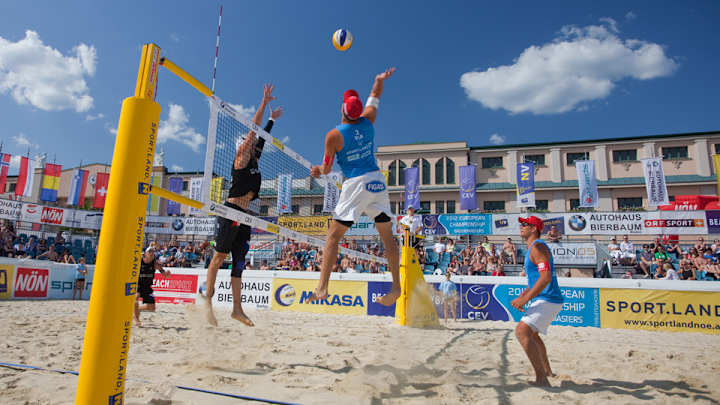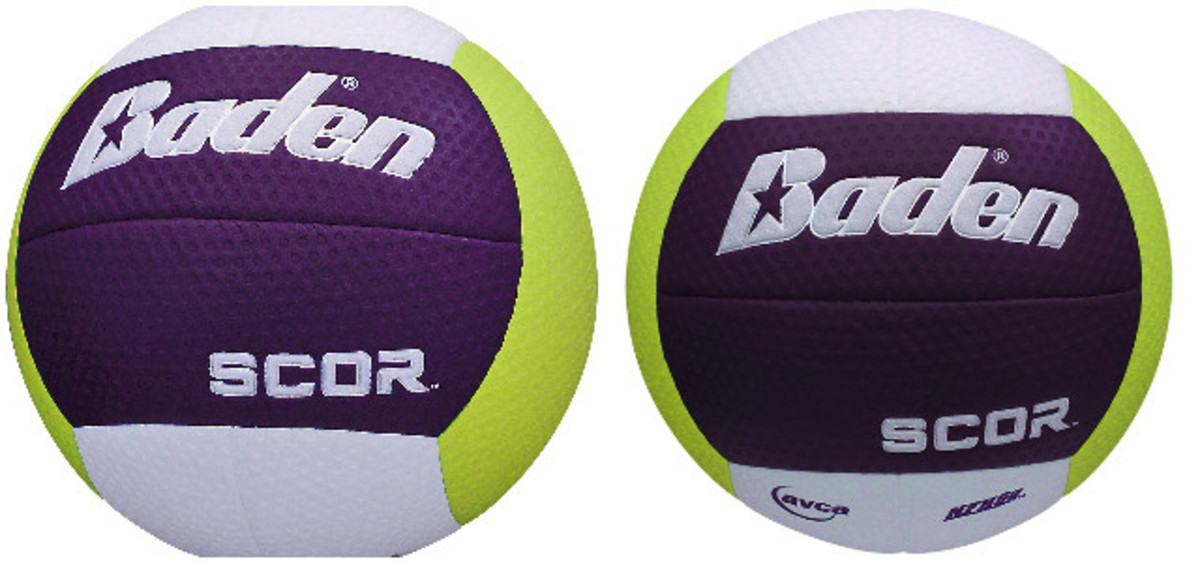Tech Talk: Baden controls spin with new microfiber volleyball

International volleyball has fallen in love with microfiber balls. But Washington-based Baden wanted to do it better, and more scientific than what we’ve already seen before the microfiber wave hits the U.S.
With three years of scientific testing backing the product, Baden created a brand-new microfiber volleyball that caters to two extreme styles of volleyball play. Baden’s Hugh Tompkins, the man behind the creation of the Baden Scor microfiber ball gave Edge an exclusive look at what makes this American-made ball a hitter’s choice.
What is it?
We’ve all seen leather volleyballs. While leather has stood the test of time as a durable material, it doesn’t lend itself to modern ways of construction and flight control. The Scor takes a dimpled microfiber skin and bonds less seems together without the deep grooves you see in a leather ball—called skiving—to scientifically define the type of movement you’ll get on the ball. By working with the depth of the dimples and the size of the skiving, this new ball offers a new flight path in the international and club volleyball world.
How does it work?
Attributes of a ball cause it to play in different ways. It is simple physics—pretending, of course, physics is simple—that uses the laws of blunt-body aerodynamics to define flight patterns. The longer you can maintain air adhering to a ball, the more accurate it will be. Baden wanted to strike the perfect balance of accuracy and creativity. Tompkins’ team did that with both the Scor’s skin and its construction.
Tech Talk: Working out the pros with the Zone 190 basketball training tool
, Baden put dimples on the ball, much like a golf ball. The dimples help form that air adhesion layer. Instead of the ball relying on seams to give it adhesion and accuracy, because seams are variable and inconsistent, Baden used dimples.
Deep skiving channels put layers of air on the ball, but leather’s deep skiving faces random directions, so you can’t get the same predictability of performance. Even float-first players find unpredictability, all depending on how the ball faces. Baden went down from 18 to 12 panels—the fewest allowed in the American game, which rules the eight-panel Mikasa illegal in the NCAA and high school—and went with wider panels to cut overall seaming down 28 percent. By nearly eliminating skiving depths, wind tunnel tests showed Baden reached a medium ground in terms of accuracy and unpredictability, allowing the dimples to give them their predictable control instead of unpredictable skiving and seams.
By colorizing the panels—Baden chose court purple and spark green—optic research showed the large blocks of contrasting colors made it easier for players to track motion and spin. “If the player has the talent to anticipate where a ball is going based on speed and spin, we want them to be able to use that advantage,” Tompkins says.
Why is it significant?
As the American game follows the international game, clubs, colleges and high schools would be left with only two choices if they move away from a traditional leather ball. The existing microfiber balls on the market—the Mikasa and Molten balls, both from Japanese companies—have distinct characteristics. The Mikasa is designed for unpredictability. “It is crazy how much it moves,” Tompkins says. “Its aerodynamic properties cause it to happen.” The Mikasa makes the float-serving set incredibly happy, but frustrates the power players. The Motlen? Expect the exact opposite. With flight stability technology, Tompkins says it is impressive how true to flight this ball is. And guess what, the power players love it and the float players hate it.
Courtney Thompson, a U.S. Olympic volleyball player who, along with teammates, extensively tested the new Scor ball, told Tompkins it takes two full practices to get used to switching between the two balls.
“We want to make a ball that would be suitable for all styles of play,” Tompkins says. “If a power player knocked the snot out of it, it would go straight. If a float server (hit it), it would knuckle unpredictably.”
What are the implications in volleyball?
By producing an American-made ball that fits American rules, but can now challenge the microfiber balls already on the international market, Baden hopes to have set itself up as the microfiber ball of choice in the U.S., for clubs and international play right down to colleges and high schools. With such science focused on the flight path of the volleyball, teams can focus on the game, not the ball.
By entering a market where two extremes already existed, Baden was able to walk the middle of the road. They also improved on some other technologies, such as adding a different way of dealing with sweat on the ball. The other microfiber balls have drying technologies on the ball’s skin, which players say forced them to soak in lotion after a game because the balls themselves removed so much moisture from their body. Baden went with a non-absorbent gripping agent built into the Truflite cover material.

What are the downsides?
Expect an adjustment period, especially from players who haven’t ever played with a microfiber ball, such as many high school players. Tompkins says initial play of the ball also plays tricks on the mind, with the softness and designs making it appear smaller and lighter, even though it is the exact size and weight of the leather offering.
One issue that delayed the launch of the Scor came as the soft, grippy microfiber was also gripping tons of dirt. “It took us a long time to solve that problem,” Tompkins says. Baden found a U.S. company able to apply a treatment to the microfiber material that helps keep dirt from adhering to the ball.
- MORE EDGE: Speedo's humpback whale-inspired swim fin
Who is using it already?
The Scor ball officially releases to the volleyball world at a convention in Oklahoma City on Dec. 17, but already the U.S. Women’s Olympic squad has play-tested the ball extensively. Expect this ball to infiltrate the U.S. club and international scene, an alternative to the two Japanese-made balls already on the market.
What is the future of it going forward?
Baden expects the club market in North America to pick up on the ball first, a market already exclusively using microfiber. As the international game continues to move into the U.S.—we have seen rule changes migrate from international to the U.S.—the less expensive nature and in-depth science behind the ball will likely entice colleges and high schools to start adopting microfiber.
Soon, Baden hopes, U.S. volleyball falls in love with microfiber too. Scor microfiber, to be exact.
Tim Newcomb covers stadiums, design and gear for Sports Illustrated. Follow him on Twitter at @tdnewcomb.
